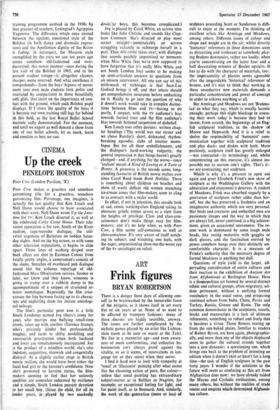Frink figures
ART BRYAN ROBERTSON
There is a danger these days of allowing one- self to be brainwashed by the inexorable force of the zeitgeist, as it shows itself in art every five or six years or so. None of us want to be affected by trumpery fashions: many of these decrees are highly resistible, anyway. The issues are further complicated by the stylistic games played by an artist like Lichten- stein (soon to be seen en masse at the Tate). We live in a mannerist age—and even aware- ness of meek conformities, and collective be- haviourism isn't always proof against the vitality, or so it seems, of innovations in lan- guage (or so they seem) when they occur.
I find it hard now to look with sympathy at `tonal' or 'illusionist' painting after what seems like the cleansing action of pure, flat colour— unless that tonal painting has extraordinary subject-matter as in Balthus or Nagritte, for example; or exceptional feeling for light, and for paint itself, as in Bonnard. And, similarly, the work 'of Ahe generation (more or less) .of sculptors preceding Scott or Sanderson is diffi- cult to enjoy at the moment. I'm thinking of excellent artists like Armitage and Meadows, among others. Different issues of colour and shape and weight are in the air; whilst directly `humanist' references in three dimensions' seem as distracting and irrelevant as somebody play- ing Brahms downstairs, rather too loudly, when you're concentrating on the latest four and a half devastating minutes of Boulez upstairs. It has to do with the character of materials, too: the impersonality of plastics seems agreeable after the uniivoidable 'historical' references of bronze, and it's nice to think that working in these unseductive new materials demands a particular concentration and power of concept in order to achieve anything at all.
But Armitage and Meadows are not 'Brahms- ian' in what they say, which- is usually laconic enough4 perhaps this slight blockage in assess- ing their work today is because they had to invent, from scratch, the beginnings of an Eng- lish sculptural tradition, in the shadow of Moore and Hepworth. And it is a relief to shelve the respbnsibility of 'humanist' com- munication together with sculptural tradition and play ducks and drakes with both. More positively, sculpture itself has greatly enlarged —not contracted—its terminology and, whilst concentrating on this exercise, it's almost im- possible not to narrow one's sights. That's it: we are contracting, not sculpture.
Which is why it's a pleasure to open out again and greet Elisabeth Frinkts new show of sculpture at the Waddington Gallery with the admiration and enjoyment it deserves. A student of Meadows, Frink was absorbed vaguely-by a generation of sculptors rather older than her- self, but she has preserved a freshness and an imaginative authority which are very personal. Her birds and creatures and embattled men are passionate images and the way in which they are always felt,.never contrived, is a big achieve- ment, given an occasional unevenness. The re- cent work is dominated by some tough male heads, like racing motorists with goggles or dark glasses, and the fascination exerted by power somehow hangs over their distinctly un- comfortable character. It is a measure of Frinke's authority that the necessary degree of formal bleakness is anything but dull.
Questions of style yield to the larger, all- pervading consideration of entire cultures and their reaction in the exhibition of Ancient Art from. Afghanistan at Burlington House. Here is a diasopopolitan art formed by several distinct ethnic and cultural groups, often migratory, sel- dom permanent, without a unifying formal vocabulary in the usual sense, and projecting continual echoes from India, China, Persia and Turkey, Russia, Greece and ROme. The only common denominator in the sculptures, vessels, books and manuscripts is a lack of ultimate refinement, something so robust and lively that it bec6rnes a virtue. Those flowers rearing up from the sun-baked plains, familiar to readers of Robert Byron, are here again, photographic- ally, and more than any of the objects displayed seem.-to gather the cultural strands together into a new dynamic: a questioning one, which brings one back to the problem of inventing an edition when it doesn't exist or hasn't for a long time—the task of English sculpture in the past forty years. I wonder if the solutions in the future will seem as confusing as this art from Afghanistan does now: we have already raided the Mayan and _Cycladic civilisations, among many others, but without the realities of trade routes and empires which determined Afghanis- tan culture.


































 Previous page
Previous page